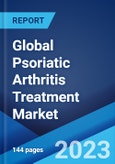The global psoriatic arthritis treatment market size reached US$ 8.7 Billion in 2022. Looking forward, the market is expected to reach US$ 15.9 Billion by 2028, exhibiting a growth rate (CAGR) of 10.57% during 2022-2028.
Psoriatic arthritis is an autoimmune disorder wherein the immune system attacks the joints and causes inflammation. Its treatment options vary from oral medications that reduce swelling and inflammation to biological therapies that target the specific immune system. It is treated as per the level of pain, swelling, and stiffness. At present, key players are introducing new treatment methods that help prevent disease progression, reduce pain, protect joints, and preserve the range of motion. These methods can be combined with physical therapy to strengthen muscles and joints and increase overall stability.
Psoriatic arthritis is an autoimmune disorder wherein the immune system attacks the joints and causes inflammation. Its treatment options vary from oral medications that reduce swelling and inflammation to biological therapies that target the specific immune system. It is treated as per the level of pain, swelling, and stiffness. At present, key players are introducing new treatment methods that help prevent disease progression, reduce pain, protect joints, and preserve the range of motion. These methods can be combined with physical therapy to strengthen muscles and joints and increase overall stability.
Psoriatic Arthritis Treatment Market Trends
Psoriasis disease is one of the major risk factors for psoriatic arthritis. As a result, the increasing prevalence of psoriasis disease due to infection, stress, obesity, skin injuries, alcohol abuse, and vitamin deficiencies represents one of the primary factors influencing the market positively. Moreover, as psoriatic arthritis occurs most commonly among individuals between the ages of 30 and 50, the rising adult population worldwide is contributing to the market growth. Apart from this, children with psoriatic arthritis are more likely to develop uveitis that affects the middle layer of tissue in the eyewall. This, in confluence with the growing concerns among parents about the health of their children, is catalyzing the demand for psoriatic arthritis treatment across the globe. In addition, the rising awareness about the benefits of early diagnosis and treatment of psoriatic arthritis, such as preventing serious damages, is bolstering the market growth. Other factors, such as inflating disposable income of individuals, improvement in healthcare facilities, and the growing health awareness among individuals, are anticipated to drive the demand for novel psoriatic arthritis treatment to combat severe symptoms.Key Market Segmentation
This research provides an analysis of the key trends in each sub-segment of the global psoriatic arthritis treatment market report, along with forecasts at the global, regional and country level from 2023-2028. The report has categorized the market based on drug type, type, route of administration and distribution channel.Breakup by Drug Type:
- NSAIDs (Nonsteroidal Anti-Inflammatory drugs)
- DMARDs (Disease-Modifying Anti-Rheumatic Drugs)
- Biologics
Breakup by Type:
- Prescription
- OTC
Breakup by Route of Administration:
- Injectable
- Oral
- Topical
Breakup by Distribution Channel:
- Hospital Pharmacies
- Retail Pharmacies
- Online Pharmacies
Breakup by Region:
- North America
- United States
- Canada
- Asia-Pacific
- China
- Japan
- India
- South Korea
- Australia
- Indonesia
- Europe
- Germany
- France
- United Kingdom
- Italy
- Spain
- Russia
- Latin America
- Brazil
- Mexico
- Middle East and Africa
Competitive Landscape
The competitive landscape of the industry has also been examined along with the profiles of the key players being AbbVie Inc., Amgen Inc., Amneal Pharmaceuticals LLC, AstraZeneca plc, Bristol-Myers Squibb Company, Eisai Co. Ltd., Eli Lilly and Company, Johnson & Johnson Service ltd., Novartis AG, Pfizer Inc., Samsung Biologics and UCB S.A.Key Questions Answered in This Report:
- How has the global psoriatic arthritis treatment market performed so far and how will it perform in the coming years?
- What has been the impact of COVID-19 on the global psoriatic arthritis treatment market?
- What are the key regional markets?
- What is the breakup of the market based on the drug type?
- What is the breakup of the market based on the type?
- What is the breakup of the market based on the route of administration?
- What is the breakup of the market based on the distribution channel?
- What are the various stages in the value chain of the industry?
- What are the key driving factors and challenges in the industry?
- What is the structure of the global psoriatic arthritis treatment market and who are the key players?
- What is the degree of competition in the industry?
Table of Contents
1 Preface3 Executive Summary12 Value Chain Analysis14 Price Analysis
2 Scope and Methodology
4 Introduction
5 Global Psoriatic Arthritis Treatment Market
6 Market Breakup by Drug Type
7 Market Breakup by Type
8 Market Breakup by Route of Administration
9 Market Breakup by Distribution Channel
10 Market Breakup by Region
11 SWOT Analysis
13 Porters Five Forces Analysis
15 Competitive Landscape
Companies Mentioned
- AbbVie Inc.
- Amgen Inc.
- Amneal Pharmaceuticals LLC
- AstraZeneca plc
- Bristol-Myers Squibb Company
- Eisai Co. Ltd.
- Eli Lilly and Company
- Johnson & Johnson Service ltd.
- Novartis AG
- Pfizer Inc.
- Samsung Biologics
- UCB S.A.
Methodology

LOADING...
Table Information
| Report Attribute | Details |
|---|---|
| No. of Pages | 144 |
| Published | November 2023 |
| Forecast Period | 2022 - 2028 |
| Estimated Market Value ( USD | $ 8.7 Billion |
| Forecasted Market Value ( USD | $ 15.9 Billion |
| Compound Annual Growth Rate | 10.6% |
| Regions Covered | Global |
| No. of Companies Mentioned | 12 |









